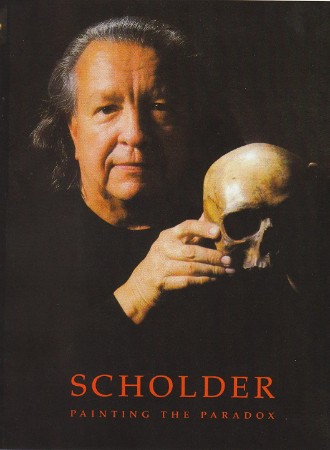
Fritz Scholder: Painting the Paradox (Artists of America Series) 1998
Distributed by Fanlight Productions, 32 Court St., 21st Floor, Brooklyn, NY 11201; 800-876-1710
Produced by International Film &
Directed by Paul Perry
VHS, color, 47 min.
High School - Adult
Art
Date Entered: 11/09/2018
Reviewed by Joan Stahl, University of Maryland, College Park, MDNarrated by Pulitzer-prize winning author N. Scott Momaday, this engrossing documentary presents the life and career of Fritz Scholder (1937 -), who became internationally known for his uniquely untraditional and unsentimental depictions of Native Americans. Scholder is of Native American descent on his father's side, but he grew up in the Midwestern and Anglicized environs of Minnesota, North Dakota, South Dakota, and Wisconsin. Although he is most closely identified with Native American subject matter and the New American Indian Art movement, his interests and art range broadly, reflecting the influences of his extensive travels and collecting. Flowers, dreams, sex, vampires, New York, ancient Egypt, and landscape are a few of the subjects he has tackled.
His work is a mixture of realism and abstraction, although abstract elements dominate. It is informed by the influences of several artists-Nathan Oliveira, Frances Bacon, and most notably, Wayne Thiebaud, his teacher at the City College of Sacramento. Like Thiebaud, Scholder works in series and prefers bold colors and flattened spaces. In this film, Scholder discusses his subject matter and his technique, which are illuminated and clarified by many examples of his paintings and sculpture, as well as scenes of Scholder painting and sculpting in the studio and at public events.
Scholder's world is divided between the Southwest and New York, where he has residences, and the many places to which he travels. Egypt and France are cited as places that have special appeal, and parts of the documentary are filmed in those locations. Through his work and his words, Scholder emerges as a serious artist, who is intellectually engaged by what he does and in search of knowledge about man's temporal and spiritual selves. He is moved by the landscape, relationships, anthropology, psychology, and an extensive and eclectic mix of objects he collects from all over the world.
The documentary is an excellent introduction to Scholder's life and works. The facts are clearly presented, and more importantly, so are the ideas that make Scholder's work exciting. As the viewer joins the artist on some travels around the globe, Scholder's own words and ideas invite viewers on an intellectual, psychological, and spiritual journey that leads them to a better understanding of his art. This film is recommended for an audience of senior high school level and above; teachers can use it as a starting point to discuss the Scholder's work, depictions of Native Americans, spiritual and psychological facets of art, and art technique.